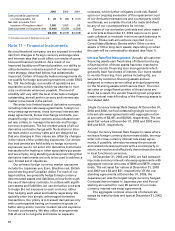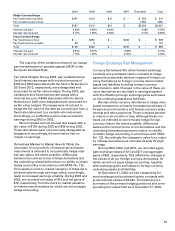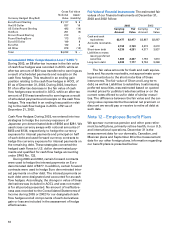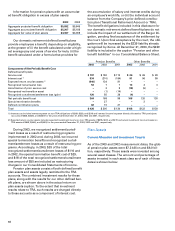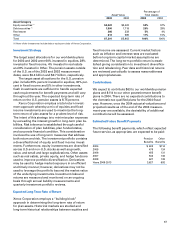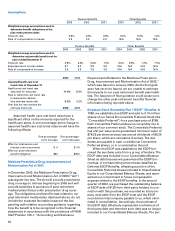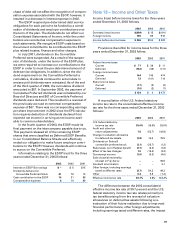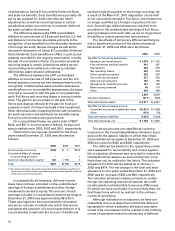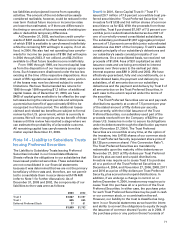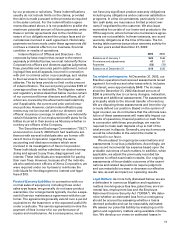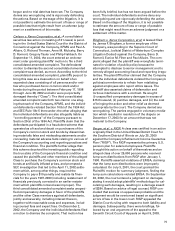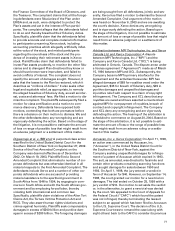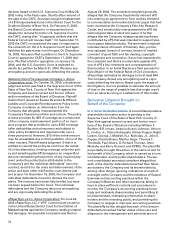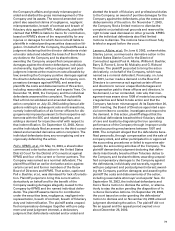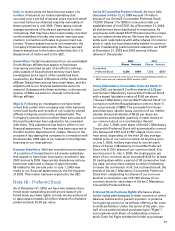Xerox 2003 Annual Report Download - page 74
Download and view the complete annual report
Please find page 74 of the 2003 Xerox annual report below. You can navigate through the pages in the report by either clicking on the pages listed below, or by using the keyword search tool below to find specific information within the annual report.
72
common stock, investors will receive such common
stock at a value of 95 percent of its then prevailing
market price. Trust II may redeem all, but not part, of
the Trust Preferred Securities for cash, prior to
December 4, 2004, only if specified changes in tax
and investment law occur, at a redemption price of
100 percent of their liquidation amount plus accrued
and unpaid distributions. On or at anytime after
December 4, 2004, Trust II may redeem all or a portion
of the Trust Preferred Securities for cash at declining
redemption prices, with an initial redemption price of
103.75 percent of their stated amount, subject to the
investors’ right to convert the Trust Preferred
Securities into shares of our common stock at the
Conversion Ratio at any time prior to any such
redemption date. The Company’s rights and liabilities
with respect to Trust II, through our other subsidiary,
contain identical conversion, put and call provisions
and would be redeemed in a similar manner as the
Trust Preferred Securities.
Trust I: In 1997, Xerox Capital Trust I (“Trust I”) issued
650 thousand of 8.0 percent preferred securities (the
“Preferred Securities”) to investors for $644 ($650 liq-
uidation value) and 20,103 shares of common securi-
ties to us for $20. With the proceeds from these
securities, Trust I purchased $670 principal amount of
8.0 percent Junior Subordinated Debentures due 2027
of the Company (“the Debentures”). The Debentures
represent all of the assets of Trust I. On a consolidated
basis, we received net proceeds of $637 which was net
of fees and discounts of $13. Interest expense, togeth-
er with the amortization of debt issuance costs and
discounts, amounted to $52 in 2003 and 2002. We
have guaranteed (the “Guarantee”), on a subordinat-
ed basis, distributions and other payments due on the
Preferred Securities. The Guarantee and our obliga-
tions under the Debentures and in the indenture pur-
suant to which the Debentures were issued and our
obligations under the Amended and Restated
Declaration of Trust governing the trust, taken togeth-
er, provide a full and unconditional guarantee of
amounts due on the Preferred Securities. The
Preferred Securities accrue and pay cash distributions
semiannually at a rate of 8 percent per year of the stat-
ed liquidation amount of one thousand dollars per
Preferred Security. The Preferred Securities are
mandatorily redeemable upon the maturity of the
Debentures on February 1, 2027, or earlier to the
extent of any redemption by us of any Debentures.
The redemption price in either such case will be one
thousand dollars per share plus accrued and unpaid
distributions to the date fixed for redemption.
Deferred Preferred Stock: In 1996, Xerox Capital LLC,
issued 2 million deferred preferred shares for
Canadian (Cdn.) $50 ($37 U.S.) to investors and all of
its common shares to us for Cdn. $13 ($10 U.S.).
The total proceeds of Cdn. $63 ($47 U.S.) were loaned
to us. The deferred preferred shares are mandatorily
redeemable on February 28, 2006 for Cdn. $90 (equiv-
alent to $70 U.S. at December 31, 2003).
Note 15 – Litigation, Regulatory
Matters and Other Contingencies
Guarantees, Indemnifications and Warranty Liabilities:
As more fully discussed in Note 1, we apply the
disclosure provisions of FIN 45 to our agreements that
contain guarantee or indemnification clauses. These
disclosure provisions expand those required by SFAS
No. 5, “Accounting for Contingencies,” by requiring
that guarantors disclose certain types of guarantees,
even if the likelihood of requiring the guarantor’s per-
formance is remote. As of December 31, 2003, we
have accrued our estimate of liability incurred under
these indemnification arrangements and guarantees.
The following is a description of arrangements in
which we are a guarantor.
Indemnifications provided as part of contracts and
agreements: We are a party to a variety of agreements
pursuant to which we may be obligated to indemnify
the other party with respect to certain matters.
Typically, these obligations arise in the context of con-
tracts that we entered into for the sale or purchase of
businesses or real estate assets, under which we cus-
tomarily agree to hold the other party harmless against
losses arising from a breach of representations and
covenants, including obligations to pay rent. These
relate to such matters as adequate title to assets sold,
intellectual property rights, specified environmental
matters and certain income taxes. In addition, we have
provided guarantees on behalf of our subsidiaries with
respect to real estate leases. In certain instances, these
lease guarantees may remain in effect subsequent to
the sale of the subsidiary. Furthermore, in certain con-
tracts we have agreed to indemnify various service
providers, trustees and bank agents from any third
party claims related to their performance on our behalf,
with the exception of claims that result from their own
willful misconduct or gross negligence. In each of
these circumstances, our payment is conditioned on
the other party making a claim pursuant to the proce-
dures specified in the particular contract, which proce-
dures typically allow us to challenge the other party’s
claims. In the case of lease guarantees, we may contest
the liabilities asserted under the lease. Further, our
obligations under these agreements and guarantees
may be limited in terms of time and/or amount, and in
some instances, we may have recourse against third
parties for certain payments we made.
Patent indemnifications – In most sales transac-
tions to resellers of our products, we indemnify
against possible claims of patent infringement caused


